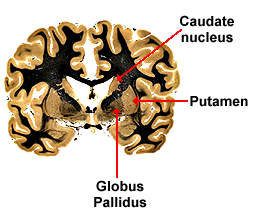| Methamphetamine May Cause Long-Lasting Brain Damage |  |
| Methamphetamine May Cause Long-Lasting Brain Damage |  |
| May 5, 2000 | It is known as ice, speed, crystal and crank. It causes massive release of the neurotransmitter dopamine in the brain. It may cause long-lasting brain damage. "It" is the drug called methamphetamine. |
 Areas of the basal ganglia examined. |
A new study (Neurology, March 2000) by researchers at Harbor-UCLA
Medical Center provides evidence that people who used methamphetamine have
significant changes in their brain chemistry. Researchers used
brain-imaging methods to compare chemicals in the brains of 26 former
methamphetamine abusers and 24 healthy, age-matched people. Researchers examined levels of N-acetylaspartate (NA), because it is thought to be a marker for neuron damage. For example, decreases in NA are seen in the brains of patients with Alzheimer's disease, multiple sclerosis, epilepsy and other neurological disorders. Compared to healthy people, methamphetamine abusers had reduced levels of NA in the basal ganglia and the white matter of the frontal lobe. People who had used the most methamphetamine had the lowest levels of NA. Two other brain chemicals, choline and myoinositol, were used to track glial cell changes. Significant increases in these chemicals were found in the gray matter of the frontal lobes of methamphetamine abusers. These increases may indicate an increase in the number of glial cells when the brain responds to injury. Researchers do not yet know if the changes in brain chemistry caused by methamphetamine abuse are permanent or how these changes might affect behavior later in life. It is not known whether the brain can repair itself with time. Additional research is needed to determine if treatments can reverse the brain damage caused by methamphetamine. |
References and further information:
|
| GO TO: | Neuroscience In The News | Explore the Nervous System | Table of Contents |
![[email]](./gif/menue.gif) Send E-mail |
 Get Newsletter |
 Search Pages |